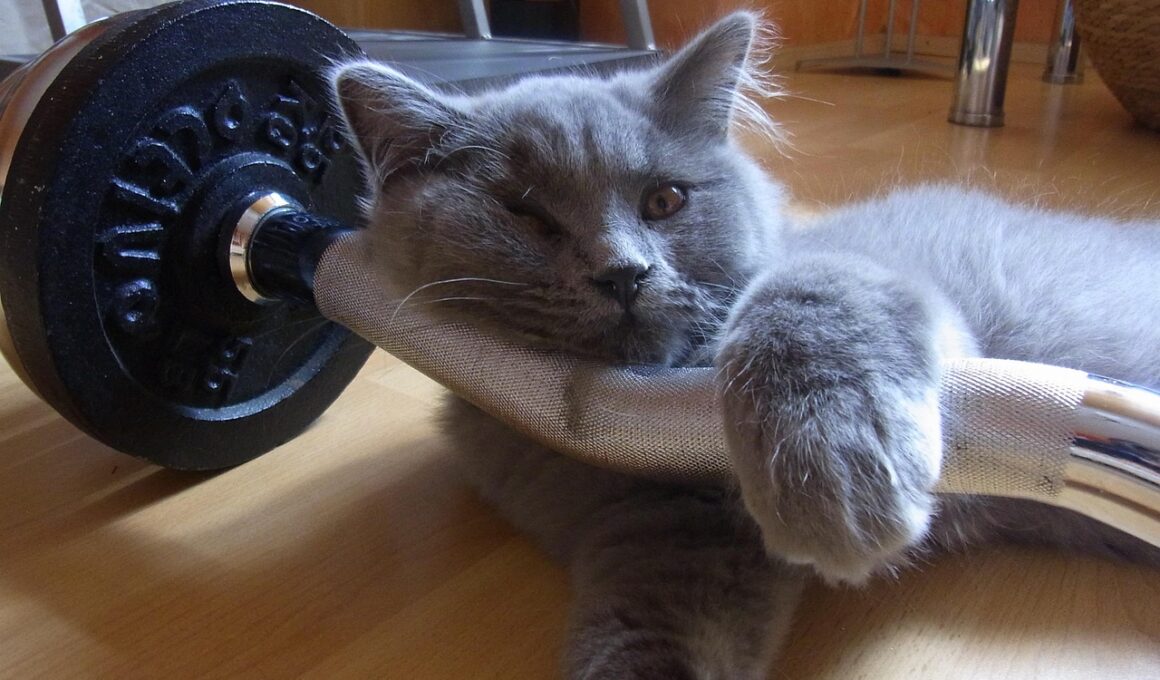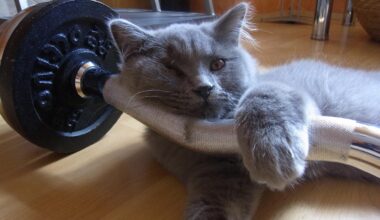Choosing the Right Cat Shelves to Optimize Training Success
Training your cat to use shelves can be an engaging experience, but it requires careful planning and suitable choices. When selecting cat shelves, consider both functionality and aesthetic appeal. Your cat needs shelves that are designed with safety features. This includes non-slip surfaces and secure mounting options ensuring stability when your cat leaps onto them. Available options range from floating shelves to multi-tiered structures, each presenting unique benefits. Some shelves are equipped with built-in scratching posts, which can facilitate more fun and interaction during training sessions. Additionally, choose shelves that match the decor of your home while meeting your cat’s needs. Create an appealing environment by incorporating stylish yet functional pieces. Observe how your cat interacts with the environment regularly and adapt training techniques based on their preferences and comfort level. Use positive reinforcement to encourage exploration of the shelves, rewarding them with treats, or praise whenever they engage with the new setup. Over time, this encourages confidence and comfort during their training on the shelves. Address any safety concerns promptly to foster an enriching training experience for both you and your furry companion.
Establishing an appropriate training regimen can greatly enhance your cat’s confidence as they learn to navigate their shelves. Start by assessing your cat’s personality and comfort with heights. Some cats are naturally adventurous and may require little encouragement to climb onto higher shelves. Others may need a gradual introduction to the concept of climbing. Utilize low-profile shelves initially to develop basic climbing skills. Placing favorite toys or treats on the shelves will motivate your cat to explore and associate positive experiences with them. Maintain a consistent training schedule that accounts for your cat’s energy levels, optimum during playtimes. Supervise their initial experiences on the shelves, ensuring that they feel secure throughout the climbing process. Over time, increase the difficulty by utilizing taller shelves as your cat grows more confident. Patience is key—give your cat plenty of time to adjust to new heights. Remember that every cat is unique and may require different training tactics. Utilize quieter training sessions if your cat feels overwhelmed. Creating a nurturing environment supports successful adaptation to the shelves, ensuring your cat enjoys their climbing adventures without fear or hesitation.
Understanding Cat Behavior with Shelves
Analyzing your cat’s behavior is crucial when introducing shelves. Cats are territorial creatures, so the placement of shelves should respect their natural instincts. Observe your cat to understand their favorite resting spots and play areas to maximize the experience. Introduce shelves where your cat naturally gravitates, whether in the living room or near a window that allows for bird watching. These high vantage points can help your cat feel secure and promote a sense of ownership over their new spaces. Make sure that the shelves are accessible, ensuring your cat can reach them comfortably. Understand that positive associations influence training outcomes. Use treats as an incentive to climb and explore the shelves early on; this builds a connection with their new environment. Pay attention to your cat’s body language during training; responsive cats will show enthusiasm through playfulness. Take note of any signs of stress or discomfort. Modify your training approach if your cat seems overwhelmed. Tracking their progress leads to successful shelf navigation using encouraging interactions to enhance the learning experience, ultimately fostering a harmonious relationship and successful training results.
Regularly assessing the layout of your cat shelves can elevate the training environment. Keep in mind that the height and distance between shelves matter. Cats are natural jumpers, but they also prefer climbing routes that feel safe. Shelves too far apart may discourage exploration, while properly spaced shelves create an enticing challenge that promotes active engagement. Ensure that all shelves have sturdy attachments to avoid accidents. Evaluate the condition of the shelves frequently, checking for wear and tear as well as potential hazards. Safety measures such as wall mounts should be prioritized. When adding new shelves, consider using the same style to maintain a cohesive look throughout your home. This also simplifies cleaning and maintenance. Remove any obstacles from the vicinity of the shelves, ensuring that your cat can leap onto them without hesitation. Provide vertical space not only aids in exploring but also in catnapping should your furry friend desire solitude. Enhance the surroundings with cat-friendly plants or environmental enrichment items that stimulate your cat mentally. Incorporating these elements leads to a comprehensive and safe environment, resulting in successful shelf training.
Ensuring Safety and Comfort
The safety of your cat during training is paramount when selecting shelves. Cats are agile, but ensuring that surfaces are stable promotes confidence as they navigate. Look for shelves made of durable materials that withstand daily use. The design must ensure they can hold your cat’s weight comfortably. Many brands offer shelves with additional features like padded surfaces or enclosed areas where cats can feel more secure. Choose shelves that are easy to clean, as proper hygiene helps keep your cat healthy. Including feline-safe materials reduces the risk of allergies or harsh reactions. Alongside structural safety, ensure the coloring of your shelves is non-toxic, especially since cats tend to scratch surfaces often. Regularly inspect the mounting mechanisms for wear to avoid accidents. Incorporate mats or carpet on shelves to add comfort and traction. This will help them feel secure and encourage exploration. Adequate lighting should also be considered when positioning shelves; good visibility helps your cat navigate better. Ensuring comfort and safety enhances the overall training process, helping your feline companion develop an affinity for their new vertical spaces.
Encouraging interaction with the shelves is integral to a successful training process. Creating a dynamic environment fosters curiosity and playfulness. Consider incorporating interactive toys that float or hang from the shelves. These items not only engage your cat but also promote physical activity, which is essential for their health. Playtime encourages your cat to feel secure in their climbing spaces. Rotate available toys frequently to sustain their interest. Developing a content cat leads to positive learning experiences. Ensure the items used are safe and free of choking hazards. You can also engage in interactive play by guiding your cat towards the shelves when using toys. This connection between play and climbing reinforces positive associations. Create a designated play area surrounding the shelves, supplemented by ample space. This aids in the exploration of various heights and encourages creativity during training sessions. Remember that patience is essential; allow your cat to discover their own comfort zones. Track their interactions to adjust your approach accordingly. This leads to a rewarding training journey that strengthens bonds while promoting health and fitness among your beloved feline friends.
Long-Term Benefits of Cat Shelves
Utilizing cat shelves not only aids training but enhances their overall quality of life. Investing in proper shelves can lead to long-term engagement and stimulation for your feline companion. These shelves provide a unique perspective for them, placing them within view of their surroundings while satisfying their climbing instincts. It transforms their environment into an active part of their life, minimizing boredom and encouraging exercise. Understanding how to optimize training outcomes with these shelves ensures you won’t find your feline indulging in destructive behavior elsewhere. Climbing on shelves results in improved mental and physical agility, promoting a healthier lifestyle for your pet. By creating these vertical spaces, you’re essentially crafting a mini jungle for your cat, establishing safe havens and territories they can explore. This sense of ownership nurtures confidence and well-being. Over time, that promotes better behavior and rapport as they associate climbing and exploration with safety and enjoyment. Moreover, well-trained cats often develop better agility and coordination, leading to fewer accidents around the house. Thus, cat shelves not only serve as training tools but also foster richer lives for our furry friends.
Lastly, monitoring the impact of training should become a vital part of the experience. Each cat bears unique responses to new environments. Pay attention to improvements in their behavior or confidence levels during training sessions. Flexible training allows adjustments as necessary to tailor to their emotional responses. This adaptability results in a positive learning experience, paving the way for a confident climber. Encouraging feedback, such as verbal praise or utilizing treats after successful climbs, inspires continuous motivation. Cats enjoy positive reinforcement as much as humans appreciate recognition. Over time, create structured plans to foster an enduring relationship based on trust and encouragement. Active participation by observing and engaging during training sessions nurtures closeness. Regularly evaluate their comfort with the shelves, adjusting the accessibility or style as your cat grows. This ongoing assessment provides opportunities to celebrate small victories while ensuring their needs are met. The culmination of safety, interaction, and monitoring leads to successful training outcomes, forging bonds that enhance both you and your cat’s lives. Through consistent effort and nurturing, you can create a fulfilling climbing experience that serves your furry friend well into their adulthood.


